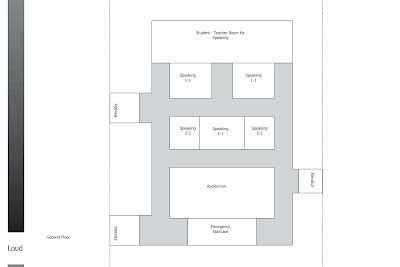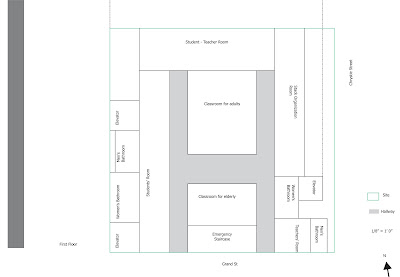
This studio considers the design of the library in terms of user interface, information structure, and media content. To create a user interface we design in section - blending surfaces to provide haptic cues for blind navigation. At the same time we organize program according to web-inspired information structures. Ultimately each project incorporates site strategy, building technology, and other agendas to enhance the library experience for blind, partially blind, and sighted individuals.
Friday, October 22, 2010
Wednesday, October 20, 2010
Tuesday, October 19, 2010
Monday, October 18, 2010
Sunday, October 17, 2010
Saturday, October 16, 2010
Bldg Site Model Facades on Grand/Chrystie
THIS HAS NOT BEEN SCALED TO THE LASER CUTTER!
It is full scale. The proportions are from the rhino model and are in feet. It still needs to be scaled to 1/8".
http://www.mediafire.com/?i8vwx67my6xyqps
Friday, October 15, 2010
site model
store fronts ~ to Gillian
Thursday, October 14, 2010
Unfolded plans

 The organizational diagrams describe (1) the collection, collision, dispersion, and control through the channeling of sound within the program of individual spaces, and (2) how the spaces organize themselves based off of a continuous central circulation with level changes. Potentially, these will be able to 'fold' into the multiple layers of the library. Following the rules set up in these diagrams, I am developing a series of plans able to describe the area taken up on the site, and more clearly show the vertical relations of program.
The organizational diagrams describe (1) the collection, collision, dispersion, and control through the channeling of sound within the program of individual spaces, and (2) how the spaces organize themselves based off of a continuous central circulation with level changes. Potentially, these will be able to 'fold' into the multiple layers of the library. Following the rules set up in these diagrams, I am developing a series of plans able to describe the area taken up on the site, and more clearly show the vertical relations of program. files for b1-2
Wednesday, October 13, 2010
Site Analysis Booklet
guided tour public library nyc
Dear class,
Last weekend I run into an interesting person, Andrew Blahnik, who is working at the public library of New York.
He works as a System Analyst of integrated library systems. For instance right now he is busy reorganizing the media system how a book gets to the user. You order it online, you select the library you want to pick it up, and it often turns out it gets lost on the way.
The even more interesting part is the fact his office is located at the Braille and talking book library. He was really interested in our design studio and is willing to give us a guided tour. He suggested we could have a look at a couple of different relevant locations of the public library, starting off at the Braille library on 6ave an 20th street.
The exact program can of course be discussed, but I think one requirement is that the tour should fit it in one morning or afternoon.
This post is to see if you all would be interested and what would be the best time to go (of course also depending on his schedule) I was thinking about coming Friday afternoon, although that might be short term. I don’t know if he would be up for it during the weekends… But otherwise what about Monday or Tuesday morning?
Please let me know, so I can contact Andrew.
See you,
Mirte
Tuesday, October 12, 2010
10/14 Studio
May I use the hand?
Sunday, October 10, 2010
Upcoming 1.5 Weeks
What is important for the midterm is the following:
1) Site Analysis Book - Produce using Rhino, Illustrator, and Photoshop, and Compile in Indesign. 2 Bound copies will be handed out at Midterm.
2) Site Model - Scale 1/8"=1'-0". Be sure to design the model with cut out for models to rest below grade as all projects will include cellar spaces.
3) Project 1B - Organizational Strategies for Expanded Program. This is the development of information structures applied to the expanded program. Spreadsheets of full program will be required to do so (include descriptions and floor areas of each spaces with areas adding up to total permitted square footage)
For 1B you will present as per the assignment.
Note that developed plans, sections, and model will be required for one scheme only.
Second organizational strategy can be a diagrammatic plan and section.
4) Completed Precedent Analysis
Again, each of you has a firm grasp of the project and your work. Be confident and productive.
Be thoughtful in how the site conditions influence the organization of views, entry, program deployment, internal circulation, etc. Document all decisions, and incorporate the strategies into your plan diagrams.
1B should refine the user interface ideas of the research assemblage, and clarify how the web inspired navigation enhances the various user experiences.
Remember that the blends are important only insofar as they serve as a user interface - they shouldn't be gratuitous.
Keep up the excellent work, and do not put off 1B. Develop the diagrams and associated plans, sections, and models on a DAILY BASIS. Post diagrams, renderings, sketches, plans, and models.... Keep me up to date on your insights, progress, and breakthroughs.
Tuesday, October 5, 2010
Monday, October 4, 2010
Bldg. Site Analysis Roles
Everyone- Required Reading- Luc Sante Low Life, "Part 1. Landscape: The Body, Home, Streets"
Alex- Light Analysis (seasonal and daylight, solar orientation) & Sightlines (various views throughout site)
Justin- Circulation Analysis & Infrastructure (sidewalks, subways, traffic, nodes of mass transportation, landmarks)
Gillian- Cultural Analysis & Typology (language, income, schools, demographics, political, public spaces, contemporary architecture, urban fabric)
Tracy- Historical Analysis (previous architecture, past demographics, political, neighborhood and regional history, public spaces, urban fabric)
Mirte- Park Analysis/System of Organization (circulation within the park too, landscape (grown v. built), public v. private) & Qualities (building and site materials, acoustic and environmental properties, problems and opportunities, secure v. insecure zones, note site areas that may be preferable to different age groups)
Han & Cheng- Topography (bldgs. and the land, landscape (grown v. built), property ownership, private v. public, contemporary architecture, neighborhood/regional history)) & Zoning (residential, commericial, institutional, cultural, set backs, air rights, zoning restrictions)
Saturday, October 2, 2010
Conventional Library
Friday, October 1, 2010
Library Structures Lecture
Monday, October 11th
1:00pm-2:00pm
Higgins Hall Auditorium
ARCH 201 Lecture: Robert Otani
Good Article on Building as Interface
http://www.theatlantic.com/magazine/archive/2010/10/design-within-reach/8220/
























